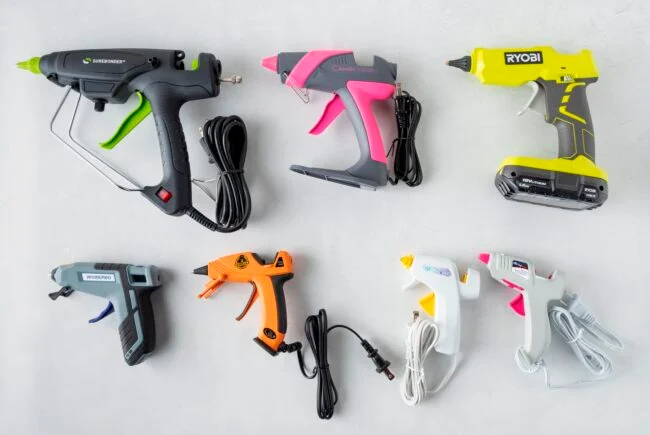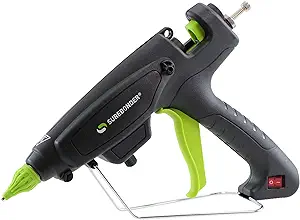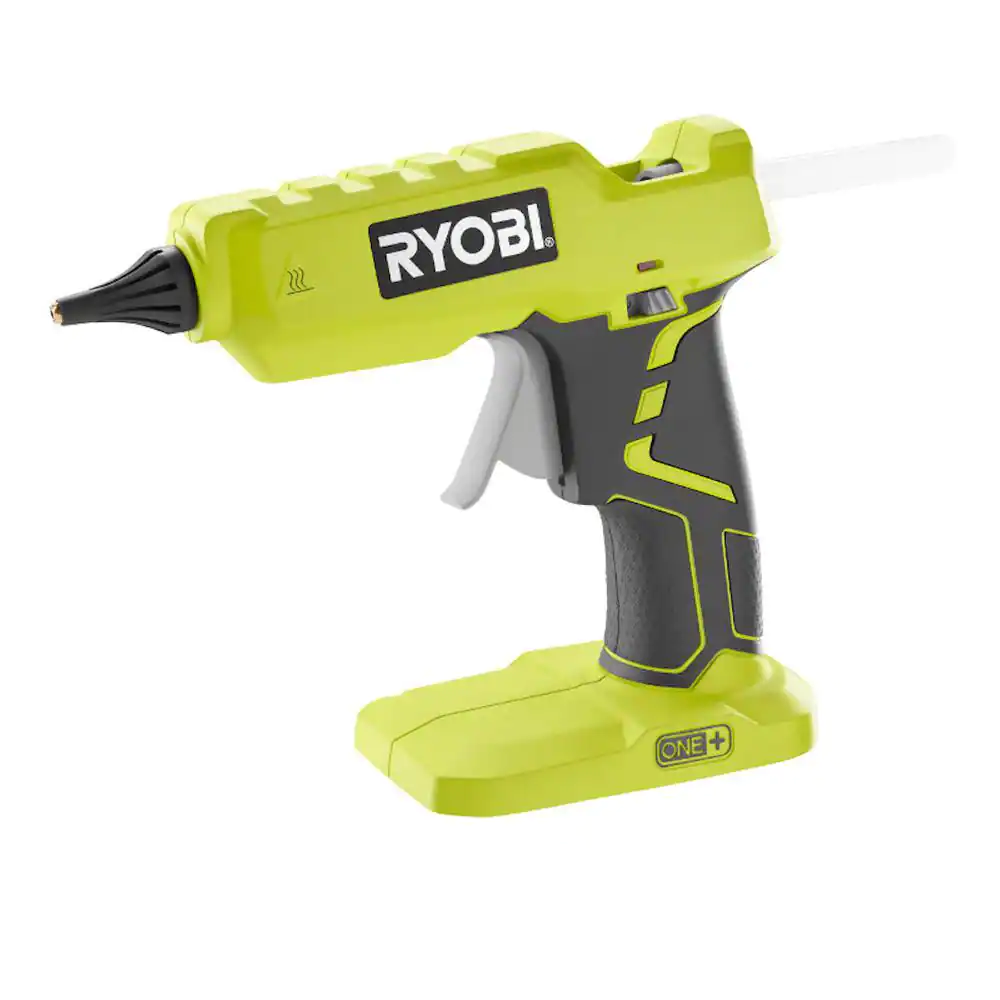Importance of Selecting the Best Glue Guns
Selecting the best glue guns is a critical decision for any DIY enthusiast, crafting professional, or even industrial worker. The choice of glue gun directly impacts the quality and durability of adhesive bonds, which, in turn, affects the longevity and integrity of the finished project.
A poorly matched glue gun may result in weak bonds, uneven application, or even damage to delicate materials. Conversely, a well-suited glue gun ensures a secure and reliable bond, enhancing the overall quality of the work.
Safety considerations cannot be understated. The right glue gun, used correctly, minimizes the risk of burns or other injuries commonly associated with hot melt adhesive applications. Understanding the nuances of glue gun selection is, therefore, an integral step towards achieving not only functional and aesthetically pleasing results but also ensuring a safe working environment.
Our Top Picks
Surebonder PRO2-220 Industrial Glue Gun
- Type: High-Temperature
- Key Features: Adjustable temperature, ergonomic design, compatible with various glue stick sizes, rapid heating, and durable construction.
Why We Love It: The Surebonder PRO2-220 is a versatile and powerful glue gun suitable for a wide range of projects. Its adjustable temperature settings make it perfect for different materials, and its ergonomic design ensures comfortable use even during extended periods.
Stanley GR20AX Trigger Feed Hot Melt Glue Gun
- Type: Dual-Temperature
- Key Features: Trigger feed for precise control, dual temperature settings, lightweight design, and a convenient fold-out stand.
Why We Love It: The Stanley GR20AX is a reliable and user-friendly glue gun. Its trigger feed allows for precise application, while the dual-temperature settings provide versatility for various projects. The fold-out stand adds convenience during work.
AdTech Pro 200 Industrial Glue Gun
- Type: High-Temperature
- Key Features: 200-watt power, comfortable grip, interchangeable nozzles, and rapid heating.
Why We Love It: The AdTech Pro 200 is a high-powered glue gun that’s perfect for heavy-duty projects. Its comfortable grip and interchangeable nozzles make it adaptable to different applications, and its rapid heating ensures efficiency.
CCbetter Mini Hot Melt Glue Gun
- Type: Low-Temperature
- Key Features: Compact size, easy-to-use, heats up quickly, and includes 30 glue sticks.
Why We Love It: The CCbetter Mini Glue Gun is an excellent choice for smaller, intricate projects. Its compact size and quick heating make it convenient for quick fixes and crafting tasks.
Ryobi P305 ONE+ Cordless Glue Gun
- Type: High-Temperature (Cordless)
- Key Features: Cordless operation, compatible with Ryobi ONE+ batteries, LED indicator, and comfortable grip.
Why We Love It: The Ryobi P305 offers the convenience of cordless operation, allowing for greater mobility and flexibility. Its compatibility with Ryobi ONE+ batteries makes it a versatile addition to any toolkit.
What to Consider When Choosing a Glue Gun
Project Type and Materials
- Different Glues for Different Materials: The diversity of materials in crafting and DIY projects necessitates the use of specific types of adhesive. For instance, wood, fabric, plastic, and metals each require a distinct adhesive formula. Hot melt adhesives come in various formulations, ranging from low-temperature glues suitable for delicate materials to high-temperature versions ideal for robust substrates. Understanding the compatibility between glue and material is fundamental in achieving durable and reliable bonds.
- Matching Glue Gun Type to Project Requirements: Once you’ve identified the materials involved in your project, it’s imperative to select a glue gun that complements those materials. Low-temperature glue guns are designed for heat-sensitive substances, while high-temperature models cater to materials that require a more robust bond. Additionally, dual-temperature guns offer versatility, allowing you to switch between settings based on project demands.
Temperature Control
- Understanding Temperature Settings: Temperature control is a critical feature of any glue gun. Different materials require specific application temperatures to ensure optimal bonding. Low-temperature settings are typically around 250°F (121°C), making them suitable for delicate materials like foam and fabrics. High-temperature settings, on the other hand, can reach up to 380°F (193°C) and are ideal for heavier substances such as wood, metal, and plastics.
- How it Affects Glue Performance: The temperature at which the glue is dispensed directly influences its viscosity, tackiness, and curing time. Using the incorrect temperature setting can lead to weak bonds, excessive dripping, or even damage to the materials. Therefore, understanding and adjusting the temperature settings according to the specific requirements of the project is paramount for achieving the desired results.
Glue Stick Size Compatibility
- Overview of Glue Stick Sizes: Glue sticks come in various sizes, ranging from standard 4-inch sticks to larger 10-inch versions. The size of the glue stick must align with the capacity of the glue gun. Larger glue guns can accommodate longer sticks, which can be advantageous for projects requiring a substantial amount of adhesive.
- Selecting the Appropriate Size for Your Projects: Choosing the right glue stick size is crucial for uninterrupted workflow. Using undersized sticks may lead to frequent interruptions for reloading, which can be particularly inconvenient during intricate or time-sensitive projects. Conversely, oversized sticks may lead to imbalance or discomfort during use. Striking the right balance between stick size and gun capacity ensures a seamless and efficient gluing process.
Ergonomics and Comfort
- Handle Design and Grip: The design of the glue gun’s handle and grip significantly impacts user comfort and control. Ergonomically designed handles with non-slip grips reduce hand fatigue during prolonged use, enhancing precision and accuracy in application.
- Weight Considerations for Prolonged Use: Glue guns vary in weight, with lighter models providing increased maneuverability and reduced strain during extended periods of use. It’s imperative to select a gun that strikes a balance between weight and functionality, ensuring comfortable operation throughout the duration of your project.
Types of Glue Guns
Temperature
Glue guns are indispensable tools in a variety of industries and DIY projects, each designed with specific temperature ranges to accommodate different adhesive materials. Understanding the distinctions between low-temperature, high-temperature, and dual-temperature glue guns is paramount in ensuring the success of any adhesive application.
Low-Temperature Glue Guns
Low-temperature glue guns, as the name suggests, operate at lower heat levels compared to their high-temperature counterparts. These guns typically reach temperatures between 250°F to 300°F (121°C to 149°C), making them ideal for delicate or heat-sensitive materials like fabric, foam, and certain plastics.
Use Cases:
-
- Crafting and Fabric Projects: Low-temperature glue guns are commonly employed in crafting endeavors such as scrapbooking, making floral arrangements, and creating fabric-based items.
- Bonding Lightweight Materials: They excel in applications where a strong bond is required for lightweight materials without causing damage or distortion.
Advantages:
-
- Reduced Risk of Burns: The lower operating temperature significantly reduces the risk of burns, making them safer to use, especially for beginners or in educational settings.
- Gentle on Delicate Materials: Low-temperature glue guns are less likely to damage or deform sensitive materials, allowing for precise and clean applications.
- Minimal Fumes: Since the glue is heated to a lower temperature, there is a reduced chance of noxious fumes or odors being emitted during use.
Limitations:
-
- Limited Bond Strength: Low-temperature glue may not provide the same level of bonding strength as higher temperature alternatives, making it less suitable for load-bearing applications.
- Not Suitable for All Materials: They may not effectively bond certain heavy or non-porous materials, necessitating the use of a higher temperature glue gun.
High-Temperature Glue Guns
High-temperature glue guns are designed to reach significantly higher temperatures, typically between 380°F to 400°F (193°C to 204°C). These guns are well-suited for materials that require a strong, durable bond, such as wood, metal, and ceramics.
Use Cases:
-
- Woodworking and Carpentry: High-temperature glue guns are frequently utilized in woodworking applications for tasks like joinery and affixing trim.
- Repairing Household Items: They are excellent for mending items like ceramics, metal fixtures, and appliances where a robust bond is imperative.
Advantages:
-
- Exceptional Bond Strength: High-temperature glue guns provide a powerful, long-lasting bond, making them essential for applications involving load-bearing or high-stress situations.
- Versatility in Material Compatibility: They are capable of adhering to a wide array of materials, including those that may be challenging for low-temperature glue.
Limitations:
-
- Higher Risk of Burns: Due to the elevated operating temperatures, users must exercise caution to avoid burns, making them less suitable for younger or less experienced individuals.
- Potential Material Damage: High-temperature glue can cause damage or deformation to heat-sensitive materials, necessitating careful consideration of the substrate.
Dual-Temperature Glue Guns
Dual-temperature glue guns offer the best of both worlds by allowing users to switch between low and high-temperature settings. This versatility makes them a popular choice for projects that involve a combination of delicate and robust materials.
Use Cases:
-
- Mixed Material Projects: Dual-temperature glue guns are invaluable when working on projects that require bonding both delicate and heavy-duty materials.
- Adaptable Crafting Applications: They are well-suited for crafting environments where a variety of materials may be used.
Advantages:
-
- Flexibility and Adaptability: Users have the flexibility to select the appropriate temperature setting for the specific materials being bonded, ensuring optimal results.
- Reduced Need for Multiple Guns: With dual-temperature glue guns, there is no need to switch between different guns for various materials, streamlining the adhesive process.
Limitations:
-
- Moderate Bond Strength: While dual-temperature guns offer versatility, they may not provide the same level of bond strength as dedicated low or high-temperature models.
- Potential for User Error: Selecting the wrong temperature setting may result in suboptimal bonding, necessitating a keen understanding of material requirements.
Choosing the right glue gun is a crucial decision that directly impacts the quality and durability of your projects. By carefully considering factors such as temperature options, project materials, glue stick sizes, and ergonomic features, you can ensure that your chosen tool aligns seamlessly with your specific needs and preferences. Safety should always be a top priority when working with a glue gun. Adhering to proper handling techniques and utilizing recommended safety gear significantly reduces the risk of accidents and injuries.





